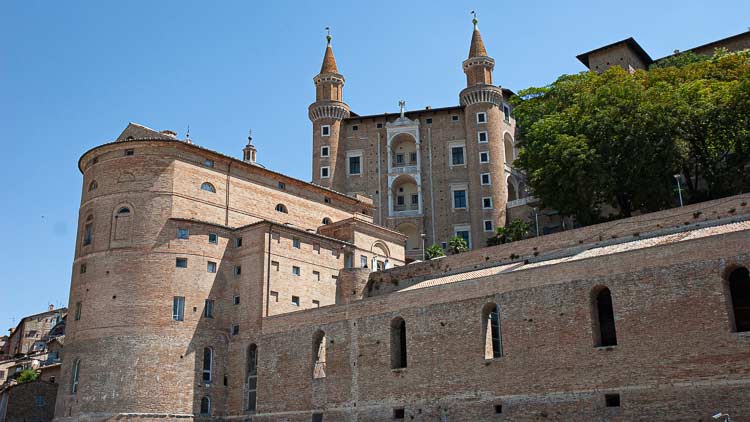Urbino, a picturesque hill town in central Italy’s le Marche region, is famous for its Ducal Palace, the first in Italy, and as the home town of the painter Raffaello (Raphael). The palace holds one of Italy’s top collections of Renaissance paintings.
In the 15th century, Duke Federico da Montefeltro established Urbino as one of the most influential places in Europe, making it an important center for art, culture and learning. Its university was founded in 1506. Urbino’s historic center is a UNESCO World Heritage site.

Plan Your Visit to Urbino
Where to Stay;- Residenza Ambrogi is a B&B with parking just outside the historic center, about a 10 minute walk to the Palazzo Ducale.
- Albergo Italia, Urbino’s first hotel, is in the historic center about a 5 minute walk to the Palazzo Ducale. Some rooms have a balcony or city view.
- B&B Albornoz, near the Fortezza Albornoz, has rooms with kitchenette.
Getting to Urbino:
Urbino is inland, about 20 miles from Italy’s east coast in the northern part of Le Marche (see le Marche region map). It’s not on the train line but it can be reached by bus from other train stations and cities, including Perugia in Umbria. The closest train stations are in Pesaro and Fano on the coast. The bus station is in Borgo Meratale by Porta Valbona. From the bus station, there are buses to the historic center. Arriving by car you can park near the bus station or in the big parking lot at Piazza Merccatale, below Urbino, from where you can walk up the hill to the center of town or take the elevator to Corso Garibaldi, a short walk to the main square.

Things to See and Do in Urbino
- The Palazzo Ducale, or Ducal Palace, dates from the second half of the 15th century. Inside are two museums, an Archaeological Museum and the Marche National Gallery, housing one of the world’s best collections of Renaissance paintings. Top things to see in the palace are the Courtyard of Honor, the Duke’s study, and the vast network of kitchens, laundry rooms, cellars, and stables. Plan to spend at least a couple of hours. It’s currently open Tuesdays – Sundays (closed Mondays, Dec 25, and Jan 1), 8:30-19:15. See Marche National Gallery for more about the museums and Ducal Palace and to check current hours and prices.
- The Duomo, or cathedral, by the Palazzo Ducale was built in the early 17th century over a 6th century religious building. Rebuilt following an earthquake in the 18th century, the duomo has a neoclassical design. Several important artworks are inside, including a painting of the Last Supper by Federico Barocci. The museum has a collection of glass, ceramics, and religious items.

- The Oratorio di San Giovanni Battista, or Saint John the Baptist, has beautiful frescoes painted in 1400 in late Gothic style depicting the life of Saint John and the town of Urbino at that time. Nearby is the Oratorio di San Giuseppe, a medieval church on Via Barocci, known for its presepio, or nativity scene.
- Fortezza Albornoz is a small fortress at the top of the town surrounded by a public park with fantastic views of the town and surrounding hills. Built in the 14th century, it was the main point of defense for the walls that were built in the 16th century. There’s also a bar near the fortress.
- Casa Natale di Raffaello, Raphael’s House, is on via Raffaello, a road leading up to the fortress. Raffaello was born in Urbino in 1483 and his family’s house is now a museum.
- Piazza della Republica is the town’s main square. It’s a good place to sit at a bar for a coffee or apertivo and enjoy the atmosphere.
Suggested Books about Urbino and le Marche
- The Light of Italy: The Life and Times of Federico da Montefeltro, Duke of Urbino
- Blue Guide The Marche & San Marino
- Italy: Umbria and the Marche (Bradt Travel Guide)
This post may contain affiliate links to sites I believe are of benefit to travelers. There is no cost to you but the small amount of revenue helps defer the cost of bringing you this free information.
Comments
Commenting is closed for this article.